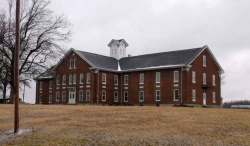Dearborn County Asylum
| Dearborn County Asylum | |
|---|---|
 | |
| Established | 1833 |
| Opened | 1882 |
| Closed | 1980 |
| Current Status | Preserved |
| Building Style | Single Building |
| Architect(s) | Alex B. Pattison |
| Location | Aurora, IN |
| Alternate Names |
|
History
The first Dearborn County Asylum was founded in 1833 on 50 acres in the NW part of the county. Twenty years later it was decided the asylum needed more land and a larger building. In 1882 land was purchased for the new asylum that stands today. The asylum was divided into a men's & women's side, by separate wings.
Although the majority of the residents were more or less mentally sound, in the early 1900s there were usually 1 or 2 violently insane residents imprisoned in a building described as the "old stone house." Conditions there were described as terrible as it had no plumbing or toilets. It was later referred to as the "smokehouse".
The asylum was intended to house up to 50 residents at one time, however it was not unusual for it to be somewhat higher. By the 1900s the majority were elderly, with smaller numbers being deaf, blind or mentally ill. Occasionally they housed orphans on their way to other institutions. Eventually the main purpose was to house impoverished elderly and was known locally as the "old folks home." Mentally ill were no longer kept here by the 1930s as they were sent to state-run facilities.
The asylum officially closed in September of 1980 due to a decline in patients and funding. 1 year later, Youth Encouragement Services, Inc(YES) opened in the asylum building. The YES home acts as foster home for minors whose parents are unable to take care of them. The rest of the property has returned to forest while 14% was sold to a farmer. The building is on the National Historic Register.

